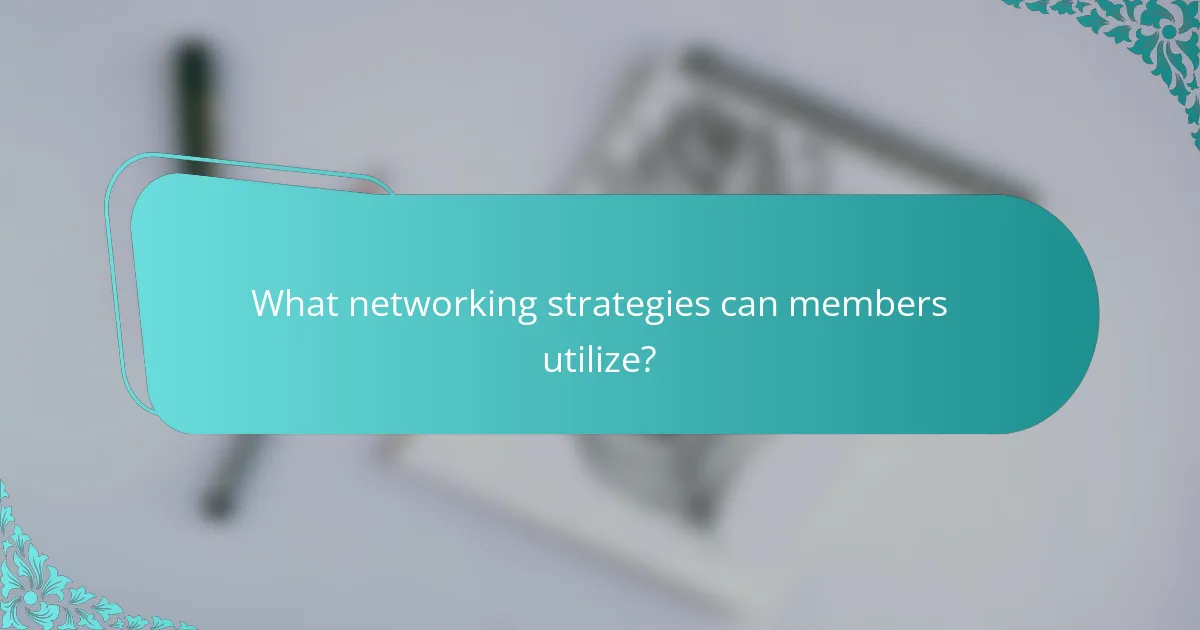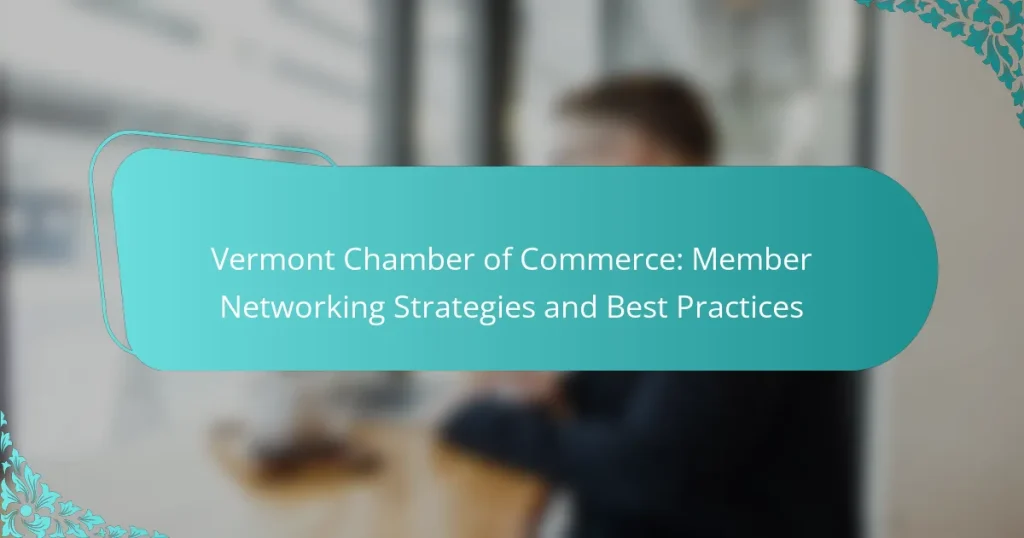The Vermont Chamber of Commerce is a nonprofit organization dedicated to representing and advocating for businesses in Vermont since 1918. It provides essential resources for networking, education, and advocacy, fostering a vibrant business environment in the state. The article outlines effective networking strategies for members, including attending events, utilizing online platforms, and forming small groups for regular interactions. It emphasizes the importance of clear communication, active listening, and following up after meetings to strengthen relationships. Additionally, it discusses setting specific networking goals and engaging in meaningful conversations to enhance overall networking success.

What is the Vermont Chamber of Commerce?
The Vermont Chamber of Commerce is a nonprofit organization that represents businesses in Vermont. It advocates for policies that support economic growth and business development. The Chamber provides resources for networking, education, and advocacy. Founded in 1918, it serves as a voice for the business community. The organization offers various programs to help members connect and collaborate. It also hosts events that promote business opportunities and partnerships. The Vermont Chamber of Commerce plays a crucial role in fostering a vibrant business environment in the state.
How does the Vermont Chamber of Commerce support local businesses?
The Vermont Chamber of Commerce supports local businesses through advocacy, networking opportunities, and resources. It represents the interests of local businesses at the state level. The Chamber engages in policy discussions that affect the business environment. It provides members with access to networking events to foster connections. These events include business expos and community forums. The Chamber also offers educational programs to enhance business skills. Additionally, it provides resources such as market research and business development tools. These initiatives collectively strengthen the local business community in Vermont.
What services are provided to members of the Vermont Chamber of Commerce?
The Vermont Chamber of Commerce provides various services to its members. These services include networking opportunities, business advocacy, and educational resources. Members gain access to events that facilitate connections with other businesses. The Chamber also offers marketing support to enhance visibility. Advocacy efforts focus on representing member interests at the state level. Educational programs and workshops are available to improve business skills. Members receive updates on relevant legislation and economic trends. Access to exclusive member-only resources further supports business growth.
How does membership enhance business visibility in the community?
Membership enhances business visibility in the community through increased networking opportunities, promotional platforms, and community engagement. Businesses that are members gain access to events where they can connect with potential customers and partners. These events often include expos, mixers, and workshops. Additionally, membership often includes listings in community directories and websites, boosting online presence. Members may also receive opportunities to sponsor community events, further enhancing visibility. According to the Vermont Chamber of Commerce, member businesses experience a 30% increase in local recognition after joining. This visibility can lead to increased customer trust and loyalty.
What are the key objectives of the Vermont Chamber of Commerce?
The key objectives of the Vermont Chamber of Commerce include promoting business growth and advocating for a favorable business climate. They aim to support member businesses through networking opportunities and resources. The Chamber also focuses on enhancing economic development in Vermont. They provide educational programs to improve business skills and knowledge. Additionally, they engage in policy advocacy to influence legislation that affects local businesses. The Chamber fosters collaboration among businesses to strengthen the local economy. Their efforts contribute to creating a vibrant community for both businesses and residents.
How does the Chamber advocate for business interests?
The Chamber advocates for business interests through lobbying efforts, policy development, and member support. It engages with lawmakers to influence legislation that benefits local businesses. The Chamber also provides resources and information to help members navigate regulatory challenges. Networking events enable members to connect and share best practices. Additionally, the Chamber promotes local businesses through marketing initiatives. These activities collectively strengthen the business community in Vermont. The effectiveness of these methods is evidenced by the Chamber’s successful advocacy on issues like tax reform and workforce development.
What role does the Chamber play in economic development?
The Chamber plays a crucial role in economic development by fostering business growth and collaboration. It provides resources and support to local businesses, helping them to thrive. The Chamber advocates for favorable policies that promote economic stability. It also connects businesses with potential partners and clients through networking events. By organizing community initiatives, the Chamber stimulates local investment and job creation. According to the U.S. Chamber of Commerce, chambers contribute to economic growth by enhancing the business climate. Their efforts lead to increased competitiveness and innovation within the local economy.

What networking strategies can members utilize?
Members can utilize several effective networking strategies. First, attending chamber events fosters face-to-face connections. These events include mixers, workshops, and seminars. Members can also leverage online platforms for networking. Utilizing social media groups enhances visibility and engagement. Additionally, forming small groups for regular meetings encourages deeper relationships. Members should also consider mentorship programs to gain insights and guidance. Collaborating on community projects can build a positive reputation. Lastly, following up after networking interactions solidifies connections and opens future opportunities.
How can members effectively network at Chamber events?
Members can effectively network at Chamber events by actively engaging with attendees. They should introduce themselves and share their business goals. Asking open-ended questions can foster deeper conversations. Members should also exchange business cards to facilitate future contact. Attending workshops and seminars offers opportunities to meet like-minded individuals. Following up with new connections post-event solidifies relationships. Utilizing social media platforms can enhance networking efforts. Participating in Chamber committees allows for ongoing interaction with other members.
What types of events does the Vermont Chamber of Commerce host?
The Vermont Chamber of Commerce hosts a variety of events. These include networking events, educational seminars, and business expos. Networking events facilitate connections among members and local businesses. Educational seminars cover topics relevant to business growth and development. Business expos showcase local products and services. The Chamber also organizes annual meetings and award ceremonies. These events aim to promote collaboration and support among Vermont businesses. Each event is designed to enhance member engagement and provide valuable resources.
What best practices should members follow during networking events?
Members should engage actively during networking events. They should prepare an elevator pitch to introduce themselves succinctly. Eye contact is essential for building rapport. Members should listen attentively to others, showing genuine interest. Following up after the event is crucial for maintaining connections. Bringing business cards facilitates easy sharing of contact information. Dressing appropriately reflects professionalism and respect for the event. Lastly, participating in discussions and asking questions demonstrates engagement and curiosity. These practices enhance networking effectiveness and foster meaningful relationships.
What are the benefits of building a network through the Chamber?
Building a network through the Chamber offers significant benefits. Members gain access to a wide range of business contacts. This enhances opportunities for collaboration and partnerships. Networking events provide a platform for sharing ideas and resources. Members can increase their visibility within the community. This visibility can lead to new customers and clients. The Chamber also offers educational resources and workshops. These resources help members improve their business skills and knowledge. Overall, networking through the Chamber fosters growth and development for businesses.
How does networking contribute to business growth?
Networking contributes to business growth by facilitating connections that lead to new opportunities. It allows businesses to build relationships with potential clients, partners, and industry influencers. These relationships can result in referrals, collaborations, and increased visibility in the market. According to a study by the Harvard Business Review, 70% of jobs are found through networking. Additionally, networking can provide access to valuable resources and information that can enhance business strategies. Engaging in networking events can also improve brand reputation and credibility. Overall, effective networking is a crucial strategy for sustainable business expansion.
What opportunities does networking create for collaboration?
Networking creates opportunities for collaboration by connecting individuals and organizations with shared interests. It facilitates the exchange of ideas and resources among members. Networking events often lead to partnerships that can enhance business capabilities. Collaborative projects can emerge from these connections, resulting in innovative solutions. Statistics show that 85% of jobs are filled through networking, highlighting its effectiveness. Additionally, collaboration through networking can lead to increased visibility and access to new markets. Members can leverage each other’s strengths to achieve common goals. Overall, networking serves as a catalyst for collaborative efforts within the business community.

What best practices should members adopt for successful networking?
Members should adopt clear communication and active listening for successful networking. Clear communication helps convey ideas effectively. Active listening shows respect and fosters connections. Members should also follow up after meetings. This reinforces relationships and demonstrates commitment. Attending events regularly builds visibility and trust. Setting specific networking goals can guide members’ efforts. Engaging in meaningful conversations leads to stronger connections. Finally, being authentic encourages genuine relationships. These practices collectively enhance networking success.
How can members prepare for networking opportunities?
Members can prepare for networking opportunities by setting clear goals. Identifying specific objectives helps focus interactions. Researching attendees or companies enhances conversation quality. Practicing an elevator pitch ensures effective self-introduction. Dressing appropriately reflects professionalism and builds confidence. Bringing business cards facilitates easy information exchange. Following up after events strengthens connections and reinforces relationships. These strategies increase the likelihood of successful networking outcomes.
What strategies can enhance member engagement during events?
Interactive activities enhance member engagement during events. Incorporating workshops, panels, and breakout sessions encourages participation. Utilizing technology, such as event apps, keeps members informed and connected. Networking opportunities should be structured to facilitate meaningful interactions. Incentives, like prizes or recognition, motivate members to engage. Feedback mechanisms allow members to voice their opinions and improve future events. Additionally, creating a welcoming atmosphere fosters a sense of belonging. These strategies collectively increase member involvement and satisfaction during events.
How can members follow up effectively after networking events?
Members can follow up effectively after networking events by sending personalized messages to new contacts. This should occur within 24 to 48 hours after the event. Members should reference specific conversations or shared interests to create a connection. Including a thank you note can enhance the message’s impact. Members can also suggest a follow-up meeting or call to discuss potential collaborations. Utilizing social media platforms, like LinkedIn, for connection requests can broaden their network. Consistency in follow-ups over time can solidify relationships. Research indicates that timely follow-ups increase the likelihood of establishing strong professional connections.
What common mistakes should members avoid when networking?
Members should avoid being overly self-promotional when networking. This mistake can alienate potential contacts. Instead, they should focus on building genuine relationships. Listening actively is crucial in conversations. Ignoring others’ input can hinder connection-building. Members should also avoid neglecting follow-up communications. Failing to follow up can lead to missed opportunities. Moreover, they should not approach networking with a transactional mindset. Building trust and rapport takes time and effort. Lastly, members should avoid attending events unprepared. Having a clear purpose and goals enhances networking effectiveness.
How can members ensure they make a positive impression?
Members can ensure they make a positive impression by being professional and approachable. Dressing appropriately for events demonstrates respect for the occasion. Maintaining eye contact shows engagement and confidence. Actively listening to others fosters meaningful connections. Offering a firm handshake conveys professionalism. Sharing relevant experiences can create common ground. Following up after interactions reinforces relationships. Research indicates that positive first impressions can significantly impact networking success.
What are the pitfalls of ineffective networking approaches?
Ineffective networking approaches lead to missed opportunities and weakened professional relationships. Poor communication can result in misunderstandings and a lack of trust. A lack of follow-up diminishes the potential for collaboration. Focusing solely on personal gain alienates others and reduces engagement. Neglecting diverse connections limits access to varied resources and perspectives. Inconsistent networking efforts can create a perception of unprofessionalism. Research indicates that 70% of jobs are found through networking, highlighting the importance of effective strategies. Without proper networking, individuals may struggle to advance their careers or businesses.
What practical tips can enhance networking success?
Building genuine relationships enhances networking success. Focus on active listening during conversations. This creates a meaningful connection with others. Attend events regularly to meet new people. Consistency increases visibility within your network. Prepare an elevator pitch to introduce yourself succinctly. This helps convey your value quickly. Follow up after meetings with personalized messages. This reinforces your interest in maintaining the relationship. Offer assistance to others in your network. Helping others can lead to mutual benefits. Join relevant groups or organizations to expand your reach. Engaging in community initiatives fosters deeper connections.
The Vermont Chamber of Commerce is a nonprofit organization that advocates for business interests and economic growth in Vermont. This article outlines how the Chamber supports local businesses through networking opportunities, advocacy, and educational resources. It details the services provided to members, the benefits of enhanced visibility within the community, and effective networking strategies for successful engagement at Chamber events. Additionally, it highlights best practices for networking, common mistakes to avoid, and practical tips to foster meaningful professional relationships.


